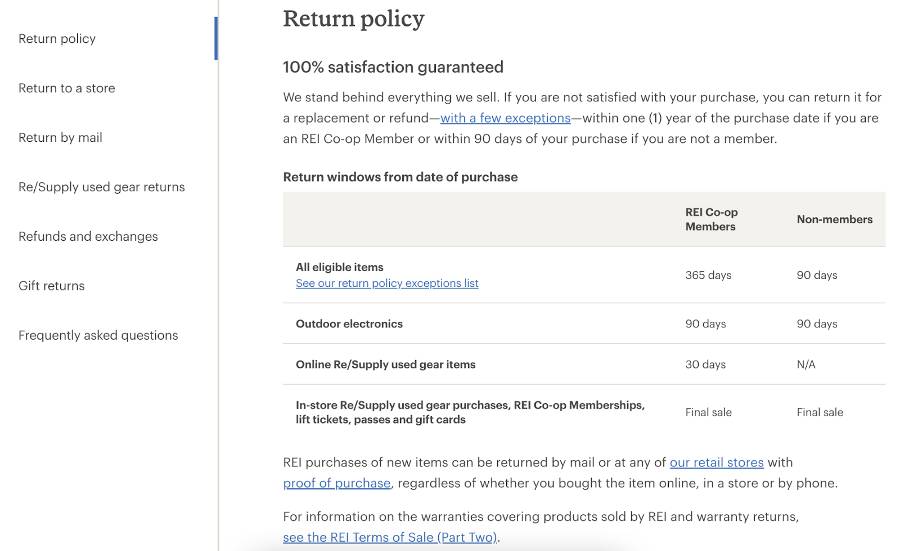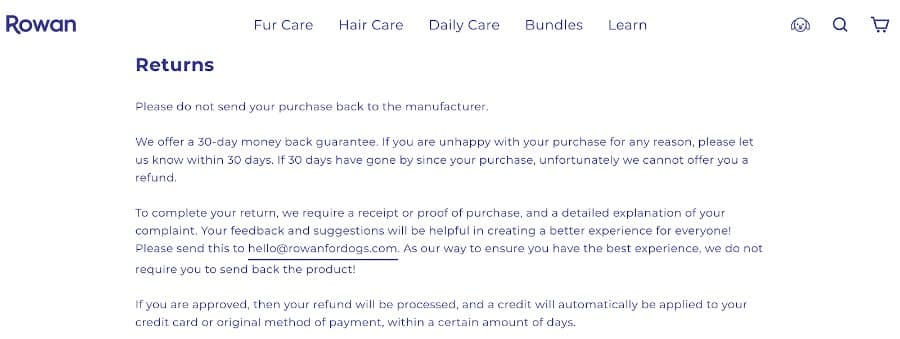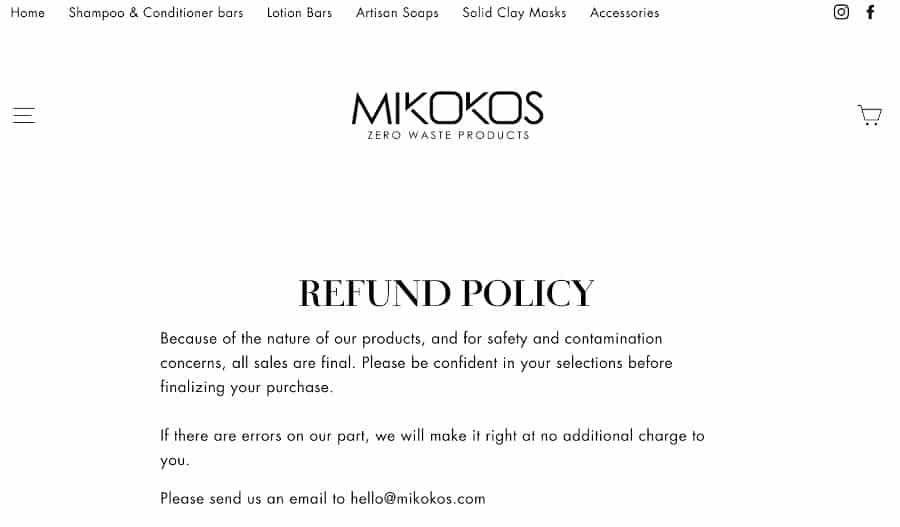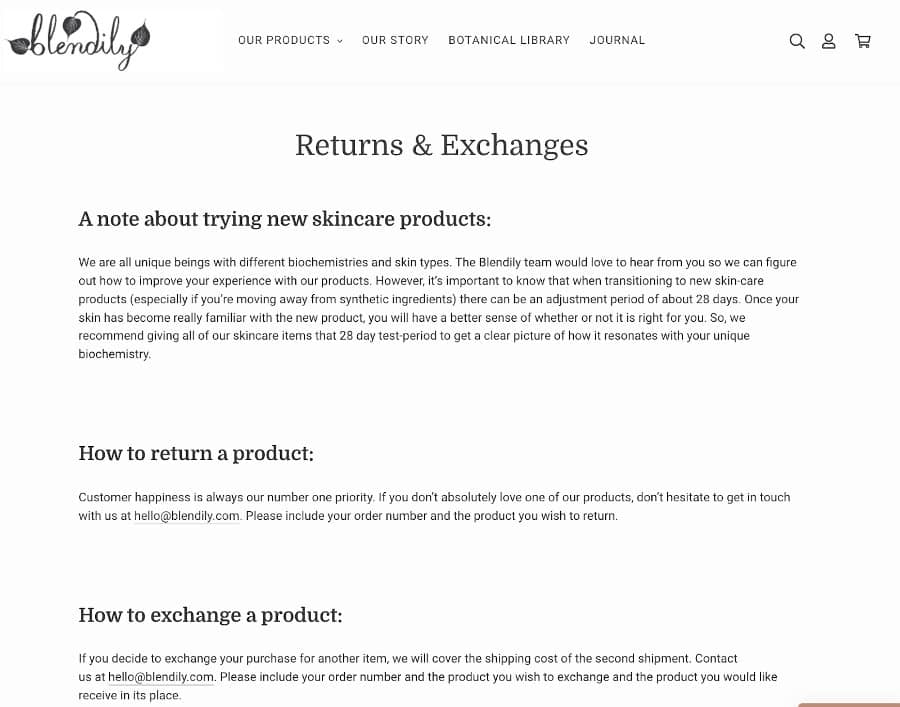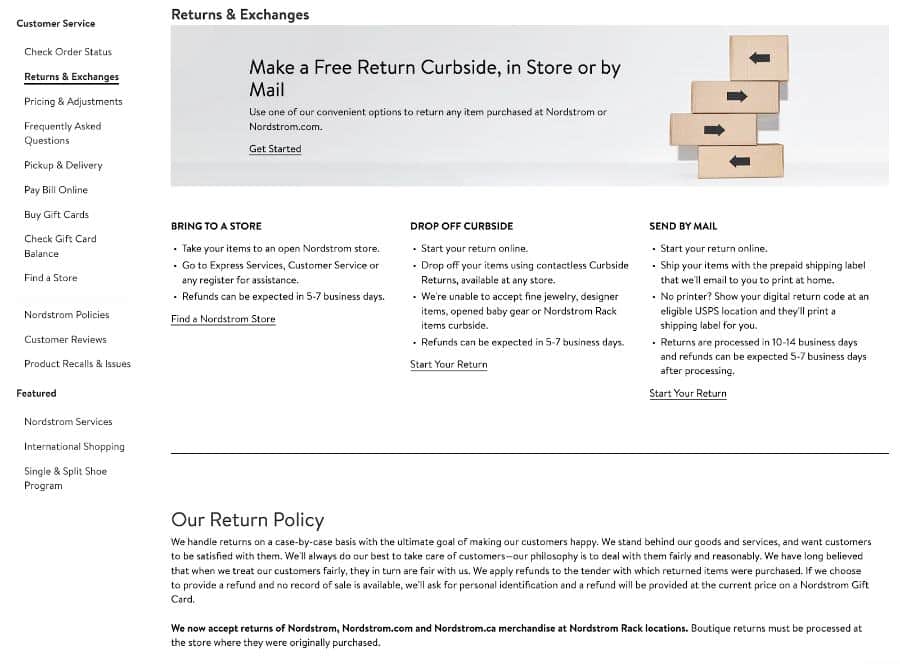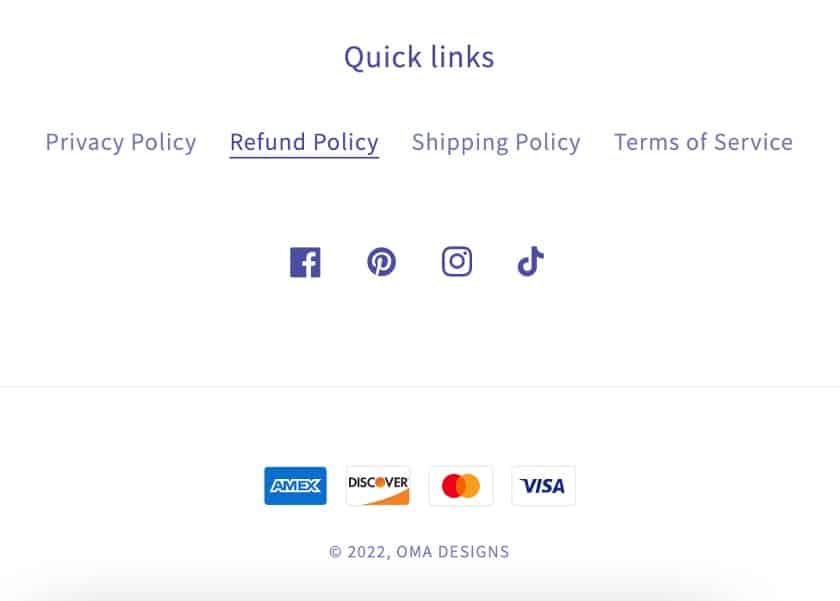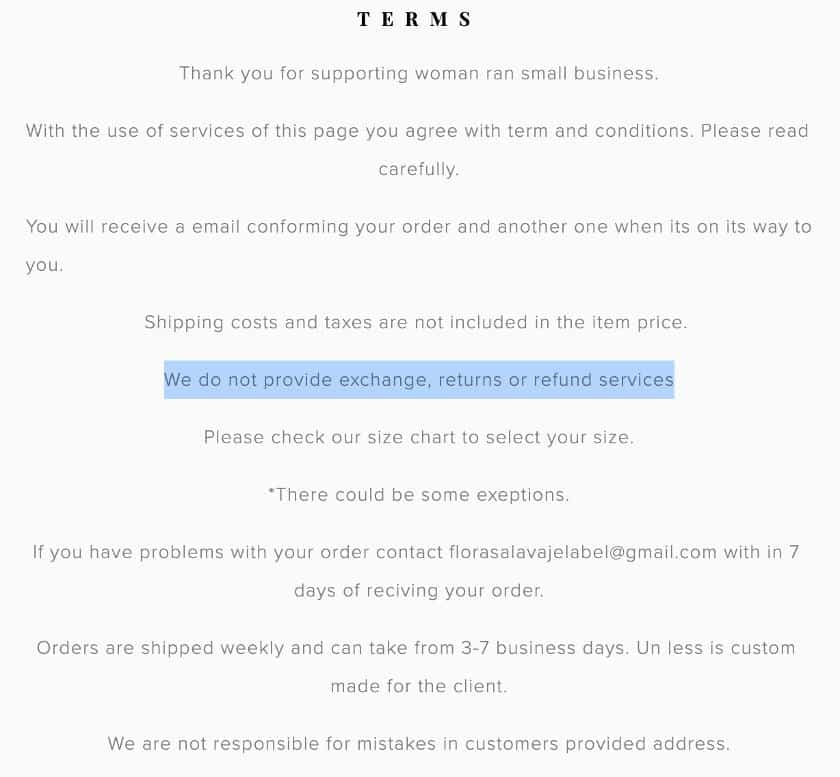Your return policy isn’t the first thing that comes to mind when starting a retail business, but it’s certainly important. Writing a return policy, which sets the terms and conditions under which customers can receive a refund or exchange items they’ve purchased, is important for any retailer. These policies are meant to protect both the business and customer by keeping the terms of the transaction transparent.
This article will go over four simple steps for creating a retail return policy for your store, including deciding what type of policy you need, drafting your policy, checking state and local guidelines, and publicly posting your policy. We’ll also cover the reasons you need a retail return policy.
If you prefer to simply copy one of our sample policies as a foundation for your own, jump down to that section of our article.
Step 1: Choose a Type of Return Policy
While retail return policies are nuanced, you can bucket them into one of four general groups:
- Unlimited returns
- Returnless refund
- Conditional return policy
- No returns—all sales final
Step 2: Draft a Return Policy With All the Right Elements
When writing your retail refund policy, you want to be as brief as possible while still covering all your bases. Use plain language that’s approachable and easy to understand—you don’t need to sound like a lawyer.
Your retail return policy should include the following:
- What is eligible for return, including time frame and type of product; note any restricted products such as undergarments for apparel retailers
- Required documentation for returns, including receipt or proof of purchase, order number, date of purchase, payment method, and more
- How to make the return, be it in person or via mail—interestingly, in-store returns are restocked 12 to 16 days more quickly than items returned via other methods
- Condition of the item being returned and whether it needs to be unopened, unused, with tags, or meet some other requirement
- Type of refund available, noting whether it’s cash, card, store credit, or exchange; remember to note the estimated time frame of payment posting
- For returns via mail, note who pays for shipping—30% of retailers make customers pay while 70% provide some form of free return shipping—how to package the return, how to get the shipping label, where to send it, and estimated time frames
- Deductions for things like restocking, shipping, price adjustments, and payment processing fees
Step 3: Check Your State & Local Guidelines
While most states don’t have any special requirements for business return policies, some have parameters you need to keep in mind. While the list below will help, it’s always best to check with your local jurisdictions for the most up-to-date and accurate information.
- California: If you don’t accept returns, you must post that information clearly in your store. Businesses in violation of these guidelines must provide full refunds for returns made 30 days from the purchase date.
- Connecticut: Businesses must post the return policy in a “conspicuous place.” Those in violation must offer refunds for unused items returned within seven days from the purchase date. Retailers can’t refund sales tax without a purchase receipt or more than 90 days post-purchase.
- Florida: Retailers must post the return policy. Failure to do so means businesses must offer refunds for purchases up to 20 days from the transaction date.
- Hawaii: The default time frame for refund eligibility is 60 days. If your return policy is otherwise, it must be stated clearly. Store credit has to stay valid for two years from the issue date, and you can’t charge any restocking or processing fees.
- Iowa: If you don’t offer refunds or you charge a restocking fee, you must inform customers. Defective items are eligible for returns by law.
- Massachusetts: Customers must be informed of or have a chance to read the return policy prior to purchase.
- Minnesota: In-store postings with your retail return policy must use “boldface type of a minimum size of 14 points.” Retailers must offer cash refunds for any item deemed eligible for return.
- New Jersey: Merchants must inform shoppers of the return policy prior to purchase. If your return policy is 20 days or less, it must be posted “conspicuously” in your store.
- New York: If your return policy isn’t posted clearly in-store, you must offer full refunds for items returned within 30 days from the purchase date.
- Rhode Island: The default time frame for return eligibility is 10 days. If the return policy is shorter than that or all sales final, shoppers must be informed.
Step 4: Post Your Return Policy Where Customers Can Find it
Creating your retail return policy is only half the battle. You have to make sure customers and employees alike are informed about the policy so everyone is on the same page. It’s important to post your retail return policy both in-store and on your website. In some states, as mentioned above, you might even be required to post in certain locations. Here are some places to consider.
Related: Best Free Customer Service Software
Retail Return Policy Templates
If you need a sample return policy to use as a base as you draft your own, you can use the free templates below. Just copy and paste and update any necessary information.
Unlimited Returns Template
The unlimited returns template should promote the customer-friendly policy as well as offer the steps required to make a return.
Then let customers know how to go about the return.
Returnless Refund Template
You can use similar copy to what we’ve drafted above for the unlimited return policy. Start out by describing your policy and any requirements:
Don’t worry about sending the [PRODUCT] back—it’s on us. We hope you’ll give us another shot in the future. In the meantime, feel free to gift the [PRODUCT] to a friend or pass it along to someone who might need or love it!
Conditional Return Policy Template
Your conditional return policy should clearly outline all stipulations. You’ll want to include a description of your return policy, the various conditions to be eligible for a refund, and how to go about it.
No Returns—All Sales Final Template
At minimum, you’ll want to use some version of the following:
You also have the option to expand on your reasoning for the no return policy. You can use something like this:
You can also offer an option to get in touch or reach out if there’s a defect or issue with an order. For example, you should make an exception to the “no refunds” policy if a customer never received their order.
Why Your Retail Return Policy Is Important
There are many reasons why more than 35% of retailers want to focus on reducing returns to boost profits and customer satisfaction. It’s expected that $816 billion in merchandise will be returned in 2022 alone. That’s nearly double the approximate $428 billion in 2020.
Industries with the highest returns rate included auto parts, apparel, home improvement, and housewares. Approximately 70% of returns happen because the customer doesn’t like the fit or style.
But having a retail return policy doesn’t necessarily make you more vulnerable to those risks. Your return policy can protect your retail business from losing money and customers to refunds. Click through the headers below for more information on how you can benefit from a strong retail return policy.
Perhaps the most straightforward reason to prioritize your retail return policy is because it can help you prevent lost profits. As many as 83% of retailers believe returns threaten profitability.
As the McKinsey report states, “In a fashion-based business, any lag time in returns can lead to significant markdowns for merchandise being resold. Brands that sell via wholesale and direct-to-consumer (DTC) channels have an added challenge: Returns from retailers often arrive all at once at the end of a season.” This leads to lower prices which eventually dilutes and cheapens your brand, and thus customers have a different perception of your brand and are less willing to pay your full prices.
When you suffer from high returns rates, you’re not only missing out on the money from those sales, but you’re also putting stress on logistics and operations. Reverse logistics creates a disjointed operational workflow, and there’s little accountability or ownership over returns. About 58% of retailers have a pain point of “lack of accountability for returns management within any single department or business unit.” This makes returns difficult to manage and optimize.
Your retail return policy can be an indirect sales tool. As many as 86% of retailers believe a lenient return policy helps increase revenue―and they’re not wrong. Many consumers check the return policy before making a purchase, and 54% of consumers say they’re not likely to make a purchase if the return policy is “poor” or “unclear.” Another 51% prefer to shop with businesses that offer the option to return to a physical store, and 44% of retailers plan to respond to this trend. Keep this in mind if you sell online in addition to your physical store.
Creating a positive customer experience is a great way to boost retention and loyalty—and one area to pay close attention to is the returns experience. Returns can make or break a shopper’s loyalty. Approximately 95% of consumers are less likely to shop with a brand after a negative returns experience.
Plus, frequent returners are often loyal shoppers. Nearly 45% of retailers find that customers who make lots of returns generally have higher lifetime value (LTV).
A retail return policy sets expectations so that customers know what the experience will be like before they even make a purchase. When the returns process goes smoothly, they’ll likely return for future purchases.
In addition to reclaiming lost profits to returns, an effective refund policy will help you save money in other ways as well. Some estimates say businesses can save as much as $125 billion collectively each year just by focusing on reducing returns. This is because you improve operational efficiency and reduce returns-related costs such as shipping, restocking, and labor dollars.
A documented retail return policy sets clear standards and parameters that ideally facilitate objective decision-making when it comes to refund eligibility. This standardization and transparency allows for effective retail store management.
It empowers employees because they’re well-informed about the return policy and can refer to it at any time. Plus, if a customer disagrees or pushes back, your team has something official to support their position. This also creates consistency for both employees and shoppers.
Returns are also a threat to the environment. Approximately 10% of all returns end up in a landfill. While that may not sound like much, it amounted to 2.63 billion pounds of waste in 2020 alone while returns shipping created 16 million metric tons of carbon dioxide. Not to mention the 16 million metric tons of carbon dioxide these emissions from transporting returns release into the atmosphere.
Why is this important? Regardless of your environmental concern, consumers are demanding more responsibility and accountability from businesses. As many as three-quarters plan to shop more with brands that attempt to create more sustainable returns processes—and 71% would pay more for environmentally responsible return methods.
Returns also make retailers susceptible to fraud. Some figures estimate that retailers lose $10.40 to return fraud for every $100 in returned merchandise.
Return fraud happens under a number of circumstances. Half of retailers have fallen victim to wardrobing, which is when a business processes returns of used, non-defective merchandise, 41.4% have processed returns of shoplifted or stolen merchandise, and 20% have been victimized by organized retail crime.
Someone could make a purchase with the intention to return it, falsify receipts, or steal an item and return it. A well-documented retail refund policy can help mitigate some of those instances.
Learn more about effective loss prevention.
Bottom Line
Your retail return policy is more than just a set of terms and conditions. It’s also a conversion and sales tool as well as a customer retention tool. Creating a well-written retail return policy improves the customer experience and protects your business from operational inefficiency and fraud, among other things. Take some time to write your retail refund policy to set your small retail store up for success.

